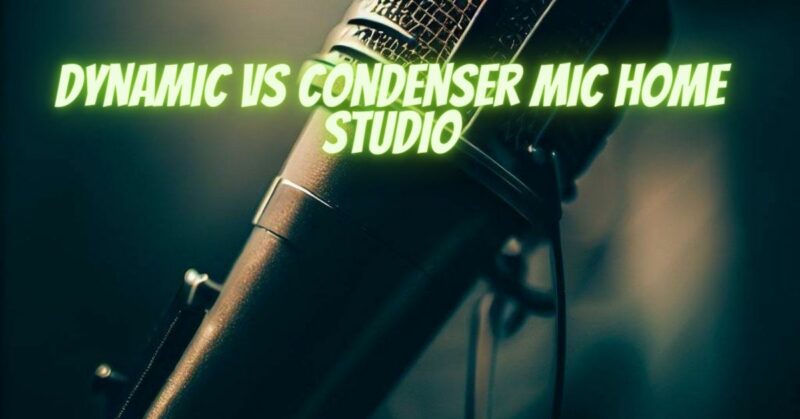When setting up a home studio, one of the most important considerations is selecting the right microphone. Two common types of microphones used in home studio environments are dynamic and condenser microphones. Understanding the differences between these two microphone types will help you make an informed decision and choose the one that best suits your recording needs. In this article, we’ll explore the characteristics and applications of dynamic and condenser microphones, so you can select the ideal microphone for your home studio setup.
Dynamic Microphones:
- Durability and Versatility:
- Dynamic microphones are known for their durability and ruggedness, making them suitable for various recording situations. They can handle high sound pressure levels (SPL) without distortion, making them ideal for recording loud instruments like drums or guitar amplifiers.
- Excellent Off-Axis Rejection:
- Dynamic microphones have a tight polar pattern, which means they are more focused on capturing sound directly in front of the microphone while rejecting unwanted noise from the sides and rear. This makes them suitable for recording in environments with background noise or in live settings.
- Lower Sensitivity and Extended Frequency Response:
- Dynamic microphones have a lower sensitivity compared to condenser microphones, which means they require more gain from your audio interface or preamp. However, they often have a broader frequency response, making them well-suited for capturing the full range of instruments and vocals.
Condenser Microphones:
- Sensitivity and Detail:
- Condenser microphones are highly sensitive and capable of capturing subtle nuances and details in audio recordings. They are commonly used for recording vocals, acoustic instruments, and studio applications where capturing fine details is essential.
- Extended Frequency Response:
- Condenser microphones typically have a wider frequency response compared to dynamic microphones, allowing them to capture a broader range of frequencies with accuracy and precision. This makes them well-suited for capturing the full tonal range of instruments and vocals.
- Power Requirements:
- Unlike dynamic microphones, condenser microphones require external power to operate. They typically require phantom power, which is provided by most audio interfaces or preamps. This power requirement should be considered when selecting a condenser microphone for your home studio setup.
| Feature | Dynamic Microphones | Condenser Microphones |
|---|---|---|
| Sensitivity | Less sensitive | More sensitive |
| Frequency response | Narrower frequency response | Wider frequency response |
| Clarity | Less clear sound | Clearer sound |
| Price | Less expensive | More expensive |
| Power requirements | Do not require phantom power | Require phantom power |
| Susceptibility to feedback | Less susceptible to feedback | More susceptible to feedback |
Choosing the Right Microphone for Your Home Studio:
- Consider the Application:
- Determine the primary use of the microphone in your home studio. If you’ll be recording vocals or acoustic instruments that require capturing fine details, a condenser microphone is an excellent choice. For recording louder instruments or in environments with background noise, a dynamic microphone may be more suitable.
- Budget and Recording Environment:
- Consider your budget and the acoustic characteristics of your recording environment. Dynamic microphones are generally more affordable and perform well in less-than-ideal recording spaces. If you have a treated or controlled environment and require high-quality recordings, a condenser microphone may be worth the investment.
- Experiment and Test:
- It’s always beneficial to test different microphones in your specific recording setup to determine which one complements your voice or instruments the best. Personal preference plays a significant role in selecting the microphone that suits your recording style and sonic preferences.
Conclusion:
Both dynamic and condenser microphones have their strengths and applications in a home studio setting. Dynamic microphones offer durability, versatility, and excellent off-axis rejection, making them suitable for various recording scenarios. On the other hand, condenser microphones excel in capturing detail, providing extended frequency response, and are commonly used for vocals and studio applications.
Consider the specific needs of your home studio, the type of instruments or vocals you’ll be recording, your budget, and the acoustic characteristics of your recording space. By understanding the differences and applications of dynamic and condenser microphones, you’ll be able to make an informed decision and choose the right microphone for your home studio setup, ensuring high-quality recordings and a great recording experience.


